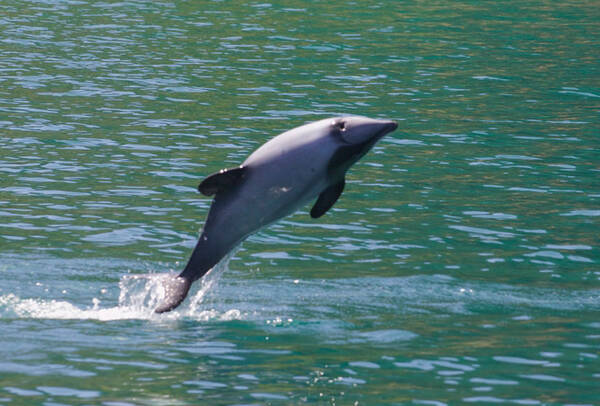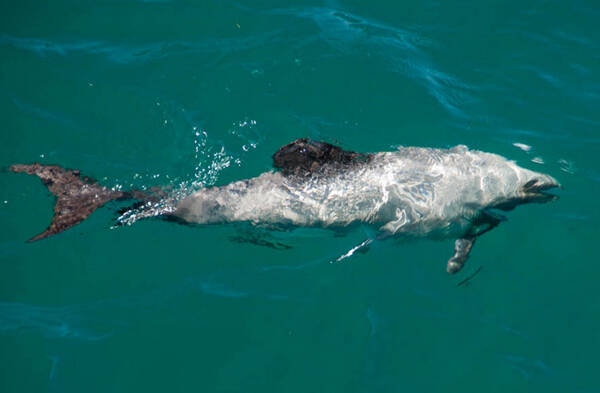Cephalorhynchus hectori
IUCN
LCBasic Information
Scientific classification
- name:Cephalorhynchus hectori
- Scientific Name:Hector's dolphin, Atlantic black and white dolphin, white-headed dolphin, New Zealand dolphin, white-headed beaked dolphin, Hector's dwarf dolphin
- Outline:Cetacea
- Family:Delphinidae D.dolphin
Vital signs
- length:1.2-1.6m
- Weight:40-60kg
- lifetime:No verification information
Feature
One of the rarest species and the smallest oceanic dolphin
Distribution and Habitat
Distributed in New Zealand (North and South Islands).
It lives in shallow marine waters, less than 100 meters deep, and usually moves within 7 kilometers of the coast. However, it has been observed as far as 35 kilometers offshore in some areas.
Appearance
The New Zealand black and white dolphin is 1.2-1.6 meters long and weighs 40-60 kilograms. It is one of the rarest species and the smallest oceanic dolphin. It has a blunt rounded head and a short, stocky torpedo-shaped body that narrows toward the tail. It has no discernible beak, which is not obvious when viewed from the side. It is short and stocky, with a sharp bulge in the back, like a hunchback. The body is thickest between the flippers and the dorsal fin. The dorsal fin is triangular, located slightly behind the middle of the body, with a sharp tip but not sickle-shaped. The flippers are small, paddle-shaped, narrow and pointed, with an arc-shaped leading edge. The caudal fin is not too large, with a notch at the central fork of the trailing edge. Dark patches surround the eyes and blowhole. The lower jaw protrudes slightly forward of the upper jaw. There are 25-30 teeth on each side of the upper and lower jaws, which are small and pointed.
The sides and back are light gray,
Details
New Zealand black and white dolphins (scientific name: Cephalorhynchus hectori) are called Hector's Dolphin and Dolphin in foreign languages. There are two subspecies.

New Zealand black and white dolphins usually gather in small groups of 2-10. These small groups sometimes temporarily unite to form larger gatherings. The swimming speed is not too fast when in a group, but it is very fast when fighting, and the instantaneous speed is estimated to be more than 20 nautical miles. When playing, they often expose half or all of their bodies above the water, splashing high waves, and sometimes use their tail fins to hit the water while circling. They mainly forage in offshore areas, and often follow prey into shallow waters along the continental shelf.
New Zealand black and white dolphins can make short dives of about 90 seconds. They use echolocation to help them find prey in turbid shallow waters in coastal waters. They feed on various small fish and squids, as well as krill, crustaceans and other cephalopods.

New Zealand black and white dolphins reproduce slowly, with a maximum annual growth rate of about 2% in the wild without human influence. Females reach sexual maturity between 7 and 9 years old, and males between 5 and 9 years old. Courtship behavior involves close contact, jumping, and chasing. During mating, the front of the male's body is almost at right angles to the female. After the penis is inserted, the tail fin swings back and forth several to dozens of times, lasting 2-6 seconds. As soon as mating is over, the female can be heard making continuous sharp sounds and many bubbles are ejected from the blowhole. Some mate once and then disperse, while others repeat mating several times within half an hour. Each female will give birth to a baby dolphin between late spring and summer at an interval of 2-4 years. 20-25 years old is the best childbearing age.
The New Zealand black and white dolphin is a species unique to New Zealand waters, and most of the species are found in the South Island. The North Island subspecies "Maui's dolphin" is only found in a small area on the west coast of the North Island. The population size today is estimated to be 27% higher than in 1970. A population survey was conducted between 1997 and 2000, with the total number of South Island dolphins estimated to be about 7,000. The North Island subspecies is much smaller than the South Island population, with only about 100 left.

The New Zealand government has established two reserves to promote the protection of New Zealand's black and white dolphins. The Banks Peninsula Marine Mammal Sanctuary was established in 1988 to protect the New Zealand black and white dolphin under the Marine Mammal Protection Act. Covering an area of 1,170 square kilometres and extending 70 nautical miles, the entire area includes the Rakaia River around the Banks Peninsula inshore and 4 nautical miles offshore. Sporting events and commercial fishing are not allowed in this area. The highest number of dolphins seen in the area was in 2006, and 65% of them enter this area to spend the winter.
Listed in the 2013 Red List of Endangered Species of the World Conservation Union (IUCN) ver 3.1 - Endangered (EN).
Listed in Appendix II of the Convention on International Trade in Endangered Species of the United Nations (CITES) in Washington.
Protect wild animals and stop eating game.
Maintaining ecological balance is everyone's responsibility!








